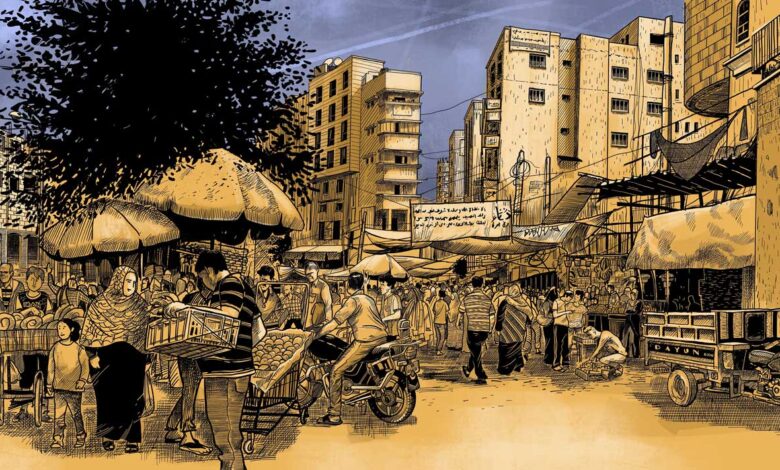Israel-Gaza war explained: why the Middle East is on the brink again

[ad_1]
Evolution of Israel’s borders
The founding of Israel in 1948 followed a period of British rule
over Palestine, a region taken from the Ottoman Empire. This was
accompanied by the implementation of the Balfour Declaration in
1917, when Britain expressed support for a “national home for the
Jewish people”. Conflicts with the Arab population ensued.
Egypt governed Gaza for almost 20 years under military rule until
Israel took control of it in 1967, along with the West Bank and
East Jerusalem. In 2005, Israel withdrew all its troops and
settlers from Gaza, and effectively isolated it from the outside
world with a fence. The following year, Hamas emerged as the
dominant political force in Gaza after winning the Palestinian
legislative election.
In 2007, Hamas expelled its rival faction, Fatah, and assumed
control inside the territory. Since then, Egypt has helped enforce
an Israeli blockade that restricts the movement of people and
goods in and out of Gaza.
*BRITISH MANDATE
Balfour Declaration commits Britain to the
establishment of a
Jewish national home in Palestine
*BRITISH MANDATE
Jewish migration from Europe accelerates, and
settlements grow in Palestinian territories
UN Partition Plan proposes an
Arab state, a
Jewish State, and a
UN-administered Jerusalem
Israel declares independence,
triggering the Arab-Israeli War
involving Egypt, Syria, Iraq, Lebanon and Jordan. War leaves
historic Palestine divided into three parts
The Six-Day War, pitting Israel against Egypt,
Jordan and Syria, results in
Israeli control of Gaza, the
Sinai peninsula,
West Bank,
Golan Heights and
East Jerusalem
The blockade of Gaza, the expansion of
Jewish settlements in the occupied
West Bank and the status of
Jerusalem remain flashpoints
Gaza today
Hamas governs Gaza, but Israel maintains full control over its
borders, airspace and territorial waters. Following the October 7
attack, Israel imposed a “total siege” on Gaza, preventing the
entrance of food, water and fuel – creating a dire humanitarian
situation. Many of Gaza’s residents are refugees from previous
wars with Israel, living in poverty and reliant on food aid.
Limited UN aid deliveries resumed through the Rafah crossing with
Egypt on October 21. But Israel has repeatedly said it will not
allow any fuel to reach Gaza, fearing militants will use it for
their own purposes.
Hamas has been designated a terrorist group by the United States
and European Union. The Islamist group, which has sworn to destroy
Israel, has launched thousands of rockets at Israel over the
years.
Israel and Hamas have fought three wars before, in 2008-9, 2012
and 2014, and Israel invaded Gaza twice, but never tried to wipe
out Hamas completely.
View of Gaza from space
The destruction of areas of northern Gaza is visible from space in
satellite images taken before and after Israel’s air strikes,
which followed the raids carried out by Hamas militants on October
7. Tightly packed streets in Beit Hanoun look obliterated in a
grey wasteland.
The pattern of destruction in the Al Karameh neighbourhood can be
traced by a widespread pattern the colour of ash.
Regional players
The war between Israel and Hamas risks spiralling into a bigger
conflict, with Israel’s arch-enemy Iran backing an array of
heavily armed groups in the region. Hamas and its Palestinian ally
Islamic Jihad are part of an Iran-backed alliance called the “Axis
of Resistance”. Others include the Lebanese Shiite movement
Hezbollah, Shiite paramilitary groups in Iraq and Yemen’s Houthi
rebels.
Hezbollah, which fought a month-long war with Israel in 2006 that
ended in a tense stalemate, poses a serious threat with an
estimated 150,000 rockets and missiles aimed at Israel. Iran also
backs Syrian leader Bashar al-Assad. During more than a decade of
civil war in Syria, Israel launched hundreds of air strikes on its
northern neighbour, primarily targeting Hezbollah fighters and
other Iran-backed forces as well as Syrian army positions.
The Israeli military has said it was prepared to fight a war on
two or more fronts. That potentially might include escalation in
the West Bank, where more than 2.7 million Palestinians live under
an Israeli military occupation. The West Bank is governed by
Hamas’ political rival Fatah. Dozens of Palestinians have been
killed in the West Bank since Israel began retaliating against
Hamas, in the worst surge of violence to have swept the West Bank
in some 15 years.
Countries that recognise Palestine as a state
On November 15, 1988, then-Palestinian President Yasser Arafat
proclaimed the Palestinian Declaration of Independence. Since
then,138 countries have recognised Palestine despite the fact it
has no defined borders. Israel is recognised by 165 countries.
Palestine is not a full member of the UN, but is a “non-member
observer state”.
Hover to get more information
Associate Creative Director Marcelo Duhalde
Edited by Andrew London
Additional web development by Dennis Wong
Sources: OCHA, UNRWA, PCBS, CENSTATD, UNOSAT, UNITAR, Worldpop,
Gaza Electrical distribution company, NetBlocks, South China
Morning Post archives, Associated Press, Reuters, Google Earth,
DW.
[ad_2]
Source link





